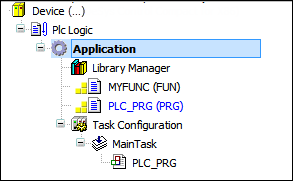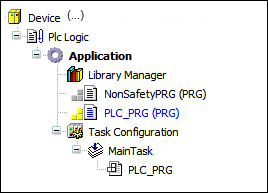Nonsafety-Relevant Programs (NonSafe PRGs)
With compiler and runtime version V3.5.4.0 and higher, PRGs can also contain nonsafety-relevant code in a Safety SIL2 application. By default, all PRGs contain safety-relevant code. This is indicated by the yellow block  symbol next to the standard POU symbol.
symbol next to the standard POU symbol.

If the above requirements are fulfilled for the compiler version and the runtime system version, then the PRG Properties dialog has a SIL2 Properties tab with the Safety-Relevant PRG where the Contains Safety-Relevant Code property of the PRGs can be deactivated. You click the Properties command in the context menu of a PRG to open the properties dialog.
If a PRG does not contain safety-relevant code, then it is indicated by the gray block  symbol next to the standard POU symbol.
symbol next to the standard POU symbol.

Notes for using nonsafety-relevant programs
The following notes explain the recommended way to use nonsafety-relevant programs. Note that the manual from the device manufacturer supplements this information.
General
Nonsafety-relevant PRGs are primarily used to execute individual nonsafety-relevant partial functions within a generally safety-critical application.
These nonsafety-relevant PRGs must not have any influence over the safety-relevant parts. Freedom from interference on safe data is done by means of a memory protection.
POUs must not be inserted below a nonsafety-relevant PRG (such as methods, actions).
Nonsafety-relevant PRGs must not be declared in the POU pool. Shared POUs should be managed in libraries.
Data access and call hierarchy
Local and global data
The location of local data from POUs depends on the type:
Function
Local variables are in the stack
FB instance
Local variables of an FB are located in the FB instance.
For global data, the following POU types can be observed:
GVL (as well as EVL)
Global variables (standard data types, FB instances, DUTs)
PRG
Global variables (standard data types, FB instances, DUTs)
The following table shows which data access is permitted in general:
Context \ Access Type | Safety-Relevant Data | Nonsafety-Relevant Data | ||
|---|---|---|---|---|
Read | Write | Read | Write | |
Safety-relevant code | OK | OK | OK | OK |
Nonsafety relevant code | OK | Not permitted | OK | OK |
Call hierarchy
The use of nonsafety-relevant PRGs (calls in or from these POUs) is subject to specific restrictions because unauthorized access can lead to the safe state of the PLC.
Call from / Call to | Safe PRG | Function (Safe-usable) | Safe FB Instance | NonSafe PRG | Function (NonSafe-usable) | NonSafe FB Instance |
|---|---|---|---|---|---|---|
Safe PRG | OK | OK | OK | Not OK | Not OK | Not OK |
Function (Safe-usable) | OK | OK | OK | Not OK | Not OK | Not OK |
Safe FB Instance | OK | OK | OK | Not OK | Not OK | Not OK |
NonSafe PRG | Not OK | Not OK | Not OK | OK | OK | OK |
Function (NonSafe-usable) | Not OK | Not OK | Not OK | OK | OK | OK |
NonSafe FB Instance | Not OK | Not OK | Not OK | OK | OK | OK |
An FB instance is generally considered safety-relevant. The exceptions are as follows:
The FB is instantiated in a NonSafe PRG.
The FB is instantiated in an EVL.
The FB instance is move by means of "attribute location".
The FB declaration is in a nonsafety-relevant library.
The TON from the standard library (Safe) is instantiated in a PRG (Safe).
Result: The TON instance is in safe memory.
The TON from the standard library (Safe) is instantiated in a NonSafe PRG.
Result: The TON instance is in nonsafe memory.
The PD from the Util library (NonSafe) is instantiated in a PRG (Safe).
Result: The PD instance is in nonsafe memory.
Important
Using a POU from a nonsafe library in a safe PRG is not allowed.
The PD from the Util library (NonSafe) is instantiated in a NonSafe PRG.
Result: The PD instance is in nonsafe memory.